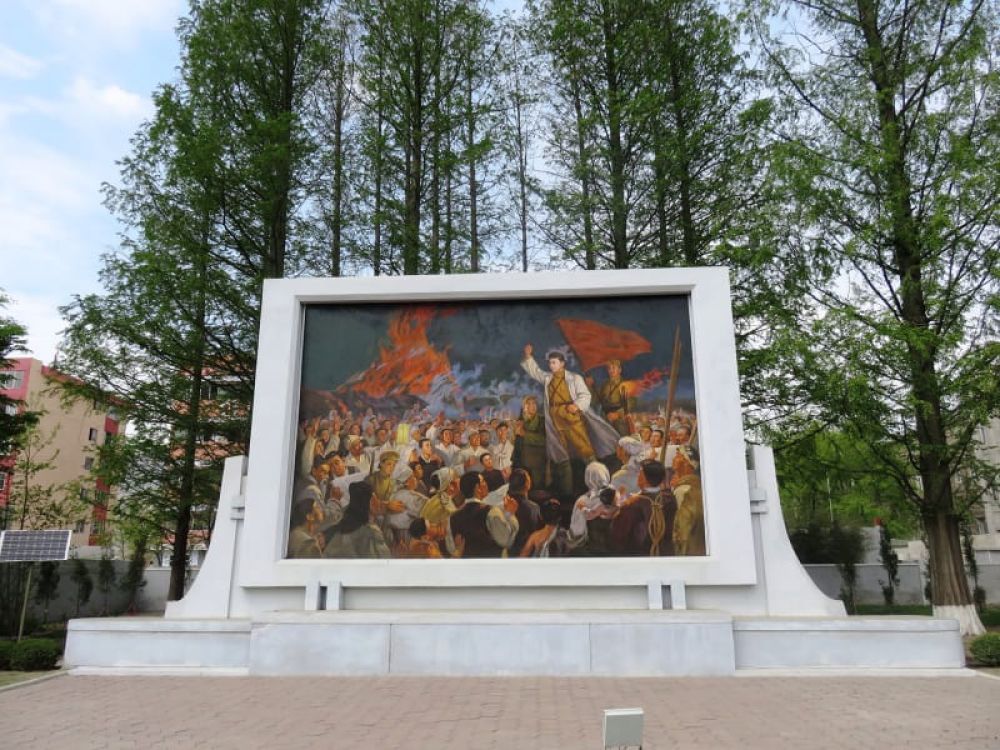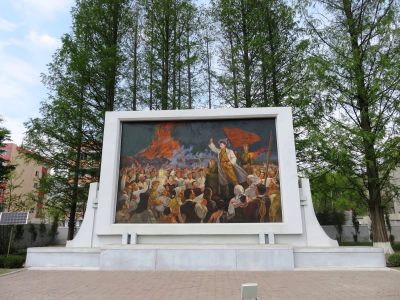

Delve into the ancient history of Korea with a visit to the prehistoric exhibit. The artifacts on display at Haeju Koryo Museum offer a glimpse into the lives of early Koreans. Here, you'll find pottery, tools, and relics from various archaeological sites. The exhibit provides detailed descriptions of the prehistoric cultures, their agricultural practices, and the evolution of their pottery techniques. As you traverse through the exhibit, you'll be able to visualize how these early communities lived, worked, and created the foundations of the society that would later become the Koryo dynasty. The museum has done a great job of curating items that tell a comprehensive story of Korea's early history, making it not only an educational experience but also a fascinating one for history buffs.
The Koryo Dynasty, which lasted from 918 to 1392, is renowned for its cultural achievements and advancements in science, literature, and especially art. The Haeju Koryo Museum proudly exhibits a selection of intricate celadon pottery, renowned for its unique jade color and delicate inlays. Exploring this section, visitors will learn about the exquisite craftsmanship of Koryo artisans and the complex processes involved in producing such elegant ceramics. Alongside pottery, there are displays featuring metalwork, including detailed Buddhist sculptures, as well as various implements used in daily life that reflect the sophistication of the Koryo society. Carefully preserved, these artifacts provide a comprehensive picture of a civilization at the height of its artistic powers.
The Traditional Korean Architecture Exhibit at the Haeju Koryo Museum presents an extraordinary opportunity to explore the design and construction techniques of ancient Korean structures. In this section, visitors can observe detailed models of traditional houses, palaces, and fortresses that highlight the harmony with nature and the efficiency of the Korean architecture of the period. Informative panels and interactive displays explain the significance of various architectural elements, such as the ondol heating system and the beautiful dancheong painting on wooden buildings. Additionally, the exhibit provides insights into how these architectural practices influenced the societal norms and cultural customs of the Koryo Dynasty. It's a perfectly curated exhibit for those fascinated by architecture and Korean history.
History enthusiasts and scholars alike will be enthralled by the collection of historical documents housed within the Haeju Koryo Museum. This activity offers visitors the chance to examine ancient texts, which include official government records, royal decrees, and historical manuscripts from the Koryo Dynasty. The documents are meticulously preserved and presented, providing an in-depth look at the administrative functions, laws, social norms, and literary achievements of the time. The museum's explanations and translations help uncover the context behind these documents, offering a rare window into the thoughts, governance, and culture of the Koryo period. For those intrigued by primary sources and the storied past they represent, this exhibit is not to be missed.
Buddhism played a significant role in shaping the cultural landscape of the Koryo Dynasty, which is beautifully reflected in the Buddhist Art Exhibition at the Haeju Koryo Museum. Visitors can explore a diverse collection of Buddhist statuary, paintings, ritual implements, and scriptures. This exhibit highlights the artistic expression and deep spiritual beliefs of the period. The intricate carvings on the statues, the serene expressions of the Buddhas, and the vibrancy of thangkas are a testament to the craftsmanship and piety of the Koryo people. The display not only showcases religious art but also explains the influence of Buddhism on society, politics, and culture during the dynasty, offering a well-rounded perspective on its role in Korean history.
The Coin and Currency Collection at Haeju Koryo Museum provides a fascinating look into the economic history of the Koryo Dynasty through its monetary artifacts. Visitors can inspect a variety of coins and currency notes which were once in circulation, providing insight into trade practices, metallurgy, and the evolution of the dynasty's economy. Each item in the collection is well-preserved and displayed alongside detailed descriptions of its historical context and usage. This exhibit not only offers a glimpse of the craftsmanship involved in creating these monetary units but also educates visitors on how these artifacts reflect the cultural and economic exchanges between Korea and its neighboring countries. The level of detail in this collection is sure to capture the interest of those who appreciate numismatics and economic history.
The Military Artifacts and Armor exhibition in the Haeju Koryo Museum showcases the strength and innovation of the Koryo military. Within this exhibit, the impressive array of weaponry, including swords, bows, and armor, indicates the martial prowess of the Koryo warriors. Visitors can see firsthand the evolution of military equipment throughout the dynasty, characterized by both functional designs and ornamental beauty. Informational boards accompany the artifacts, explaining their usage in battles and the strategic military techniques employed by the Koryo forces. For anyone interested in military history, tactics, and technology, this collection provides a compelling display of Korea’s historic defense and warfare.
Experience the day-to-day lives of the Koryo people through the Cultural and Folk Life Gallery at the Haeju Koryo Museum. This exhibit immerses visitors in a vibrant recreation of traditional Korean life, presenting various artifacts related to agriculture, food, clothing, and entertainment. Detailed dioramas and mannequins dressed in period apparel offer a window into past lifestyles and social customs. Alongside these exhibits, tools and domestic items provide an understanding of the ingenious ways in which the people of Koryo managed their households and engaged in community events. The hands-on displays and multimedia presentations make this gallery particularly engaging for families and educators looking to impart knowledge about Korean heritage.
The Calligraphy and Painting Section of the Haeju Koryo Museum celebrates the delicate and poetic art forms that flourished during the Koryo Dynasty. As visitors walk through this gallery, they can admire the brushwork and aesthetic beauty of traditional Korean calligraphy and paintings, some of which depict landscapes, historic events, and scenes from everyday life. Alongside the visuals, the exhibit explains the philosophies and emotions conveyed through these art forms, as well as the materials and techniques used by the artists. This collection offers a peaceful and reflective experience, especially for those with an appreciation for the finesse and depth of classical Asian art.
The Interactive Learning Center at the Haeju Koryo Museum is an ideal activity for students, educators, and anyone interested in a hands-on approach to history. The center offers various interactive exhibits designed to engage with visitors of all ages, encouraging them to participate in traditional crafts, solve historical puzzles, and play games related to the Koryo Dynasty. The environment is educational and fun, ensuring that all participants leave with a better understanding and appreciation of Koryo history and culture. This center emphasizes experiential learning, making the rich history of Korea accessible and entertaining to everyone.
